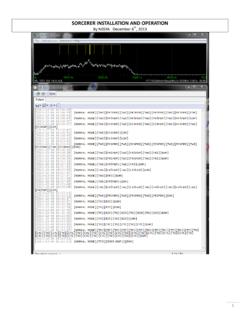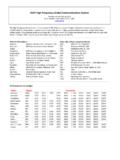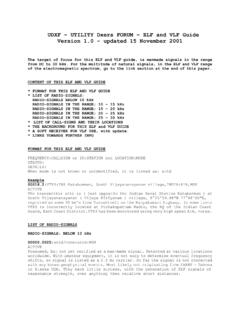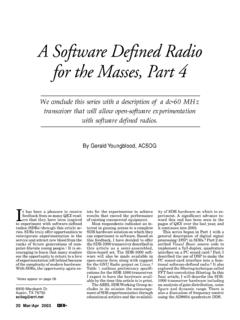Transcription of The RTL SDR V3 - Utility DXers Forum
1 the rtl sdr v3 (or, Eight Bits On HF) By D. B. Gain Purpose and Scope; To see what you get using an $20 8bit ADC (Analog to Digital Converter chip featuring an ENOB of 7) SDR (Software Defined Radio, a radio that is "defined" by the software employed to control it as to frequency ranges covered and methods of tuning and demodulation) and commonly used often free software such as SDR#, HDSDR and other SDR control apps as well as decoding apps for operation in the HF environment. Yes I know this is a tall order for HF work but I'm intrigued by the minimalist (in hardware as well as expense) aspect of an 8bits on HF paradigm.
2 Radio Hardware; RTL-SDR Blog on the internet recently touted a new RTL dongle, one with improved performance over run of the mill RTL dongles. The fine folks at RTL SDR Blog were kind enough to send me a sample RTL SDR V3 dongle and antenna kit, this is the dongle used throughout the review. If you didn't know, the RTL USB dongles are originally manufactured for VHF/UHF digital TV broadcast reception via a pc and were found to be hackable for general radio pursuits such as scanning, trunked radio system tracking, APCO25 and other digital modulation scheme decoding, as well as other radio endeavours in the 25 to 2000 MHz range.
3 You plug the dongle into a handy USB port, fire up the control app (after installing a driver and/or dll for the dongle perhaps), and off you go into the vast new world of SDR radio. A world rich in Software Defined Radio and all it entails. AMBC band displaying several IBOC HD stations Notice I didn't mention HF in the paragraph above. That's because the RTL dongles aren't designed for HF reception at all. This is where the hack comes in, some fine folks discovered that one could control the various I/Q channel inputs via software, not only to allow coverage from 25 to 2000 MHz, but by using the direct sampling input, provide for HF coverage from around 500 KHz or a bit lower to 30 MHz.
4 Some dongles lacking hardware support for direct input mode will require a hardware modification to allow for direct input HF use, typically the soldering of a single wire from the antenna connector to one of the ADC input pins. This HF capability is what made me jump at the chance to test one of these RTL's as I'm an insolvent HF fanatic. Normally one wants more than an 8bit ADC to get sufficient gain and dynamic range on HF (or anywhere else), somewhere along the lines of 14bits and up will do very well, 24bits would get you a theoretical 144dB dynamic range (dynamic range is the ability to copy weak signals undistorted in the presence of much stronger nearby and not so nearby signals, very similar to being able to hear a whisper spoken to you while standing next to a jet engine at full afterburner), but a inexpensive 24bit chip that can handle HF has yet to enter the hobbyist market, so the 8bit chips are the price leader.
5 These higher bit ADC chips exist in the marketplace, but typically in the form of military and government surveillance receivers that come with high prices. Oh by the way, there's a 24bit or better ADC sitting in the CD/DVD player of your PC. Some of the consumer grade SDR radios aimed at the HF market are of the 12 to 16bit range and these do nicely in the crazy HF environment, especially when one gets to 14bits and above. The jump from 8bits to 12bits is on the order of 6 times the price of the 8bit V3, but the jump from 12 to 14 bits is around three times the price or more of the 12bit SDRs. The way I look at it, the jump from 8 to 12bits gets you about 15 to 20dB dynamic range increase, which is very noticeable and useful and is a game changer compared with 8bits.
6 The performance difference between a 12bit ADC and a 14bit ADC is closer than the performance difference between an 8bit ADC and a 12bit ADC. I guess what I'm really waiting for is the time when future 32bit chips are as cheap as the 8bit ones of today, however long that may take. The physical properties of said dongle are about a thumb's length and half thickness of a thumb, with a USB connector on one end and an antenna port on the other. The dongle comes with a mag mount antenna base with attached coax and SMA connectors and two telescopic rod antennas, one of impressive stature. The V3 can also be purchased by itself for a bit less money.
7 The new RTL dongle sports an shiny aluminium case to keep signals in or out of the SDR as the case may be, said case also acting as a nice heat sink, and has a measure of noise and interference reduction in the circuit board itself compared to previous RTL dongles, especially with regard to the USB line and switching mode power supply, very welcome advances in the dongle art. Typically these dongle have a plastic case and are thusly prone to allowing interfering signals from the pc and other in home devices as well as the local RF environment to spoil the signals before they enter the pc through the dongle and SDR app.
8 Another advance is the presence of a TCXO, or Temperature Controlled Crystal Oscillator. Co-channel FAX on S4285 Signal The TCXO reduces the oscillator drift that arises normally from internal component temperature variations due to operation and environmental factors by keeping the crystal that the reference oscillator is derived from at a more constant temperature, negating drift after a few minutes of warmup. I can vouch for the RTL V3 TCXO's abilities to keep you on frequency with little or no drift, at least on HF. The dongle also sports a SMA antenna connector, one will have to obtain an SMA to whatever coaxial connector one uses.
9 I obtained a SMA to UHF adapter, lightweight so as to keep stress off the antenna connector in the RTL V3. PC Hardware; I used a PC with a 4 core Intel CPU, Intel mobo, 4gb ram, and 32bit Win7 OS. The onboard HIDEF sound system handles the sound routing via the stereo mixer. The particular sound system has a max sampling rate of 48 KHz but that works out just fine for HF decoding apps and general HF listening. As the max audio bandwidth I use for HF reception (and feed to decoder apps) is 10 KHz or less, 48 KHz is more than enough to satisfy the Nyquist criterion. Harry Nyquist said you have to sample a given signal of interest at least twice its highest frequency to reproduce the sample digitaly without loss or distortion.
10 In regards to sampling analog things into the digital world we should listen to Harry Nyquist, he knows what he's talking about. A soundcard typically takes analog signals presented to it, runs them into an ADC (analog to digital converter chip), manipulates them digitally and then sends them off to speakers or an application, via a DAC which is the reverse of a ADC, a digital to analog converter. Antenna System Hardware; The antenna for HF used in this review was a off center fed dipole up around 30ft, RG6 cable TV coax feedline, and a Barker and Williamson 30 MHz lowpass filter. Ferrite beads were placed on the antenna end and connector end of the coax to reduce noises traveling upon the coax outer shield.




